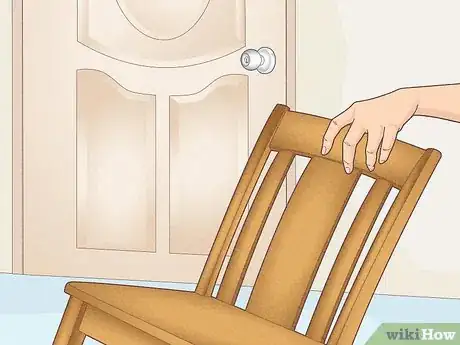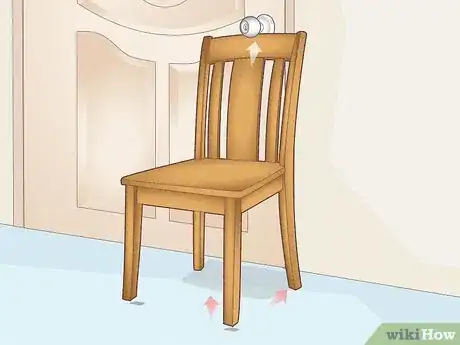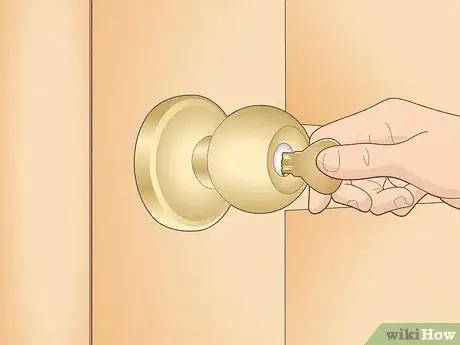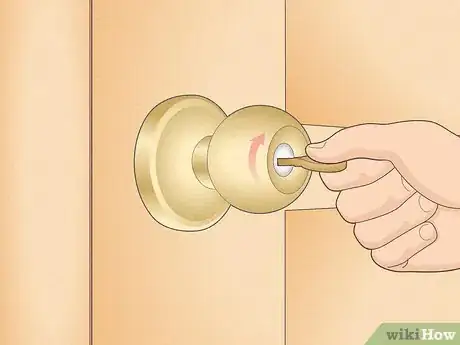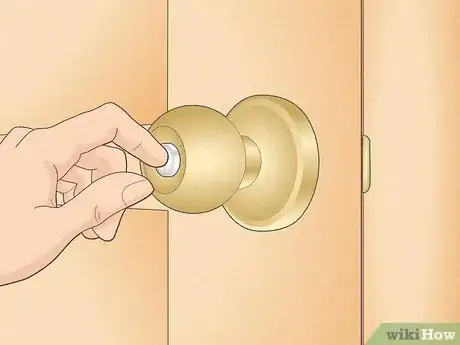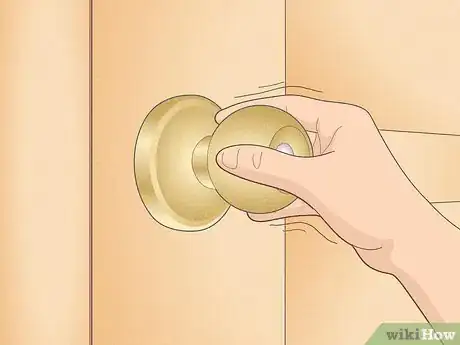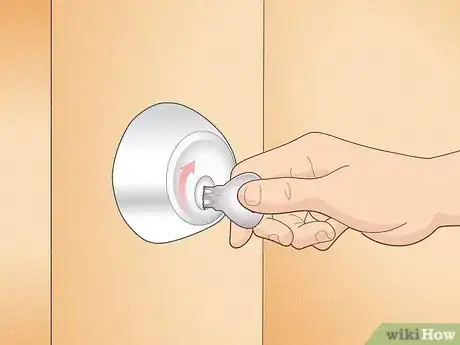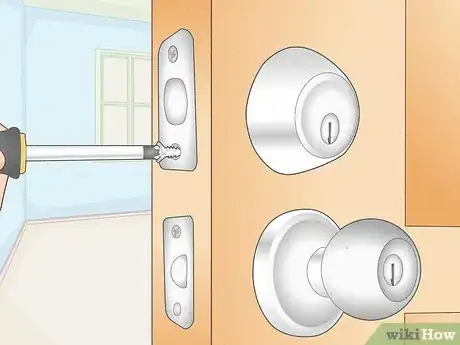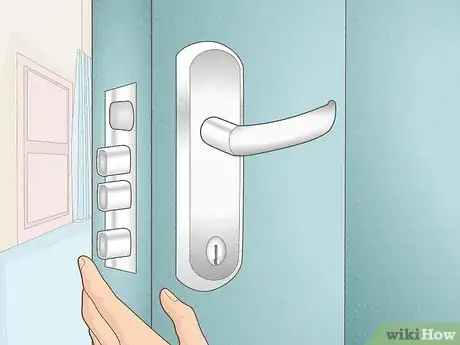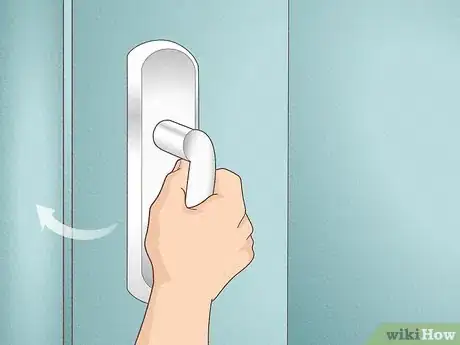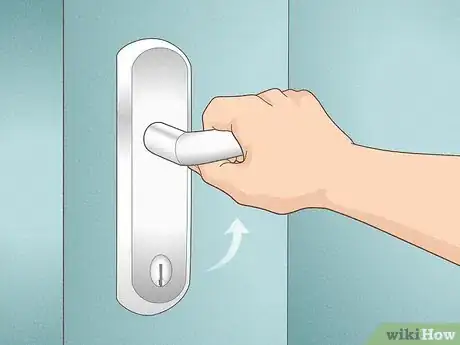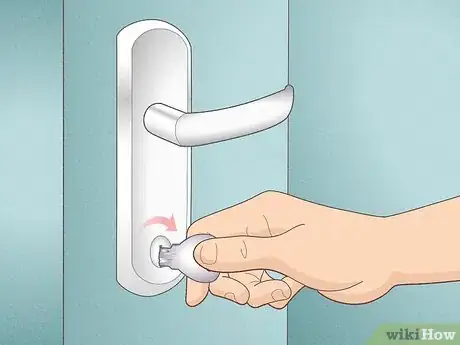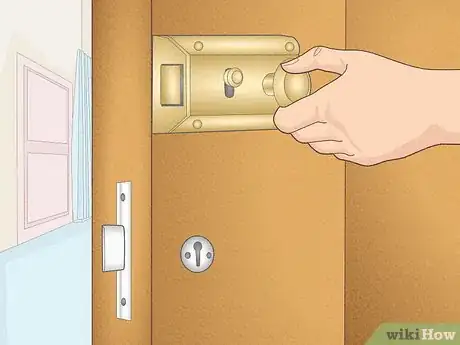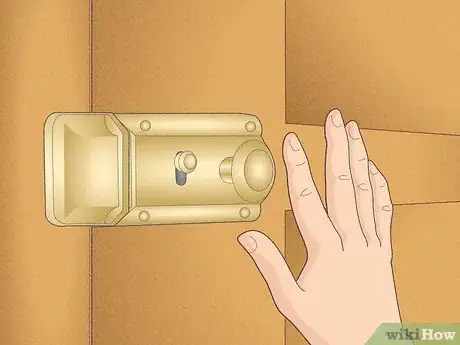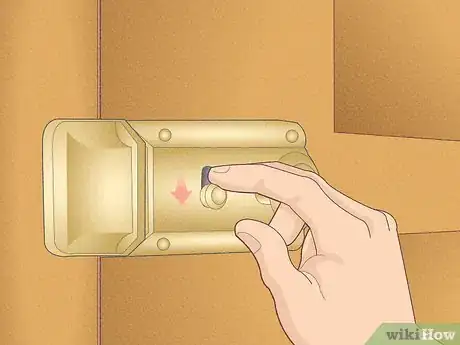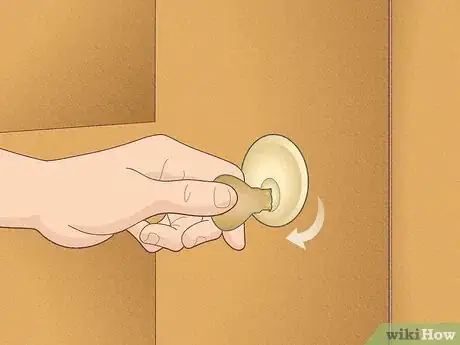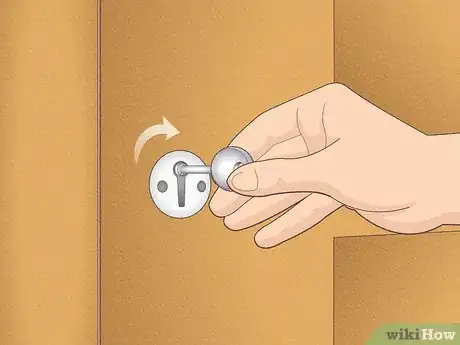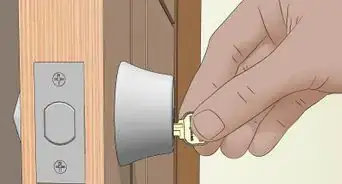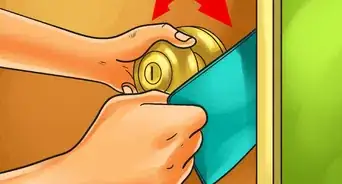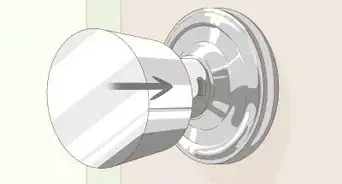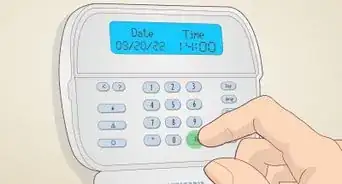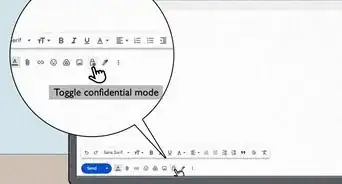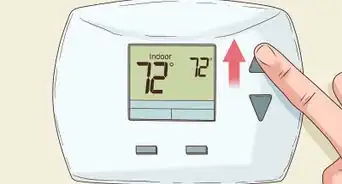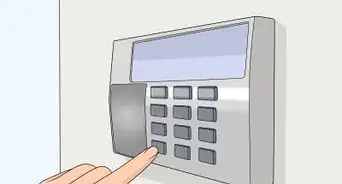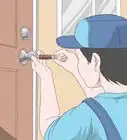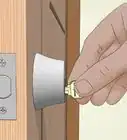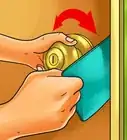wikiHow is a “wiki,” similar to Wikipedia, which means that many of our articles are co-written by multiple authors. To create this article, 23 people, some anonymous, worked to edit and improve it over time.
This article has been viewed 376,932 times.
Learn more...
A locked door will turn away most would-be intruders. Most locks slide a bolt from the door into the door-frame, rooting the door to its foundation. In order to lock a door, you usually just need to know how to slide this bolt. If you are trying to secure a door that doesn't have a lock, try propping a chair underneath the doorknob to keep it from being easily opened.
Steps
Locking a Door With a Chair
-
1Jam a chair under the doorknob. You may have seen this in the movies – and it really works! Bear in mind that this method only works if the door opens inward.[1]
- Warning: If someone tries to force the door open from the outside, there is a chance that the chair will break. This is a trick, not a fail-proof security system.
-
2Find a sturdy chair. Do not use a folding chair. Close the door and stand inside, so that the door opens toward you. Wedge the top of the back of the chair underneath the doorknob, between the knob and the door. The two front legs of the chair should not be touching the ground.Advertisement
-
3Wedge the chair as close to the door as you can. The chair should apply pressure to the door, at an angle, focused just beneath the doorknob. This will make it much more difficult for a casual intruder to open the door.[2]
Locking a Doorknob
-
1Find the keyhole. If your doorknob is accompanied by a lock, you should see a jagged slit on the outward-facing knob of the door. There should be a locking button on the inside part of the knob. The jagged slit is the keyhole. If you have a key for this door, it should fit perfectly into the keyhole and will allow anyone with that specific key to enter the premises.[3]
- The inside lock button will usually appear in two forms: a twist-lock or a push-lock. Both buttons are typically made from the same metallic material as the doorknob. The twist-lock button is often circular, with a pointed ridge down the center. The pointed ridge is for your finger to twist the lock. Normally, if you twist it right it will lock the door, and if you twist it right, it will unlock it. The push-lock button is a small cylinder. It isn't the most common type of lock these days, but you will see many of them in public restrooms.
- If the doorknob does not have a keyhole or a lock button, then it does not lock. Try replacing the doorknob with a lockable handle.
-
2Make sure that your key fits. Slide the key into the keyhole of the outer doorknob. If the key will not fit, flip it upside down and try again. The key may have one jagged edge and one smooth edge, or it may have multiple jagged edges. These jagged ridges along the length of the key are what match it to this particular lock. The more jagged the key, the tighter the security.[4]
-
3Lock the door from the outside. Close the door while you are standing outside. Slide the key into the keyhole and turn it clockwise as far as it will go. If you turn the key far enough, the door should lock. If this does not work, flip the key upside down and try again.
- To remove the key, turn it counter-clockwise back to the position at which you slid it in – but no further. Pull the key out of the keyhole.
- To unlock the door from the outside, simply slide the key into the keyhole and turn it counter-clockwise as far as it will go. Once again, if it does not work just flip the key upside down and try again. You should feel the doorknob release. It should turn, now. Remove the key from the lock.
-
4Lock the door from the inside. You don't need a key to lock most doors from the inside. Find the push-lock or twist-lock button on the inner doorknob.
- If your knob has a push-lock: You should see a small, cylindrical button protruding from the center of the knob. Push the button. This should lock the door. Turn the knob to make sure that the door is locked. To unlock the door, simply turn the knob from the inside; it will not unlock if you turn it from the outside.
- If your knob has a twist-lock: You should see a circular button with a ridge down the center. Pinch the ridge and twist the button clockwise as far as it will go--likely a 90-degree quarter-turn. This should lock the door, but turn the knob to make sure. To unlock the door, simply twist the button counter-clockwise as far as it will go.
-
5Make sure that the door is locked. Try to turn the doorknob and push the door open. If the knob turns and the door opens, then you didn't lock the door. If the knob rattles, but does not turn, then you have locked the door.
Locking a Deadbolt
-
1Check your door for a deadbolt. The deadbolt should be a circular piece of metal, anywhere from a few inches to a few feet directly above the doorknob. The deadbolt functions just like the doorknob, but it uses a different key and its bolt is much heavier. On the outside of the door, the deadbolt should look like another keyhole. On the inside of the door, the deadbolt should feature a heavy, rotatable switch. A locked deadbolt will keep the door from opening even if the doorknob turns.
- If your door doesn't have a deadbolt, do not worry. A deadbolt is not an essential security feature, although it will make your door even harder to break through.
-
2Lock a deadbolt from the outside. If you have a key for the deadbolt, use it. This key should be different from the key that fits the doorknob. Close the door and stand outside. Slide the key into the deadbolt keyhole and turn it clockwise as far as it will go. If you turn the key far enough, the door should lock.
- To remove the key, turn it counter-clockwise back to the position at which you slid it in – but no further! Pull the key out of the keyhole.
- Try to turn the doorknob and push the door open. If the door will not budge, then you have successfully locked the deadbolt. To unlock the deadbolt, simply turn the key counter-clockwise as far as it will go – just like the doorknob.
-
3Lock a deadbolt from the inside. You don't need a key to lock a deadbolt from the inside. Locate the twistable switch on the inner side of the door. Turn the switch clockwise as far as it will go. This should slide the deadbolt into place.
- To unlock the deadbolt, simply turn the switch counter-clockwise as far as it will go. This will retract the heavy deadbolt back into the door.
-
4Consider installing a deadbolt. This can be a great way to lock down your house if you are especially concerned about security. Assess your need for privacy. A deadbolt will make your door harder to break through, but it also means another key to keep track of.
- Consider hiring a locksmith to install a deadbolt. The process can be tricky if you are not experienced with locks or woodworking, You don't want to damage your door!
Locking a PVCu or Composite Door
-
1PVCu and Composite doors are locked with multipoint locking systems that lock the door into the frame at multiple points.
-
2Close the door into the frame.
-
3Pull the handle up to engage the multipoint lock.
-
4Turn the key or thumb turn in the cylinder to prevent the lock from being disengaged.
Locking a Wooden Door
-
1There are two main types of lock on a wooden door - night latches and mortice deadlocks.
-
2Close the door into the frame. The night latch will spring into its catch and hold the door in place.
-
3Push the snib down on the night latch to prevent the lever or latch from operating, even from outside.
-
4If locking from the outside with a compatible night latch, turn the key in the cylinder towards the latch frame to deadlock the lock.
-
5Insert the correct key into the mortice deadlock and turn towards the latch frame in order to deadlock the door.
Community Q&A
-
QuestionWhat can I do if the chair is too small?
 Community AnswerGet a bigger chair, if possible, or get a piece of wood and nail it horizontally across your door on both sides.
Community AnswerGet a bigger chair, if possible, or get a piece of wood and nail it horizontally across your door on both sides. -
QuestionHow can I lock my door when other people have a key?
 Community AnswerYou could install an interior door latch, something that you physically latch when you are inside to keep you safe. If you are in an unsafe situation and people are using their keys to gain access to your room either with the intent to hurt you or steal from you, call your nation's emergency number.
Community AnswerYou could install an interior door latch, something that you physically latch when you are inside to keep you safe. If you are in an unsafe situation and people are using their keys to gain access to your room either with the intent to hurt you or steal from you, call your nation's emergency number. -
QuestionWhat if my chair is easy to break?
 Community AnswerDon't use that chair. Find another chair that won't have as much of a chance of breaking.
Community AnswerDon't use that chair. Find another chair that won't have as much of a chance of breaking.
References
About This Article
To lock a door without a key, start by finding a sturdy chair that isn't a folding chair. Then, close the door you want to lock so you're standing on the side that it opens into. When you're ready, wedge the top of the chair underneath the doorknob. Try to get the chair as close to the door as possible, which will apply pressure to the door so it can't be opened from the outside. To learn how to lock a door from the inside or outside using a key, keep reading!

